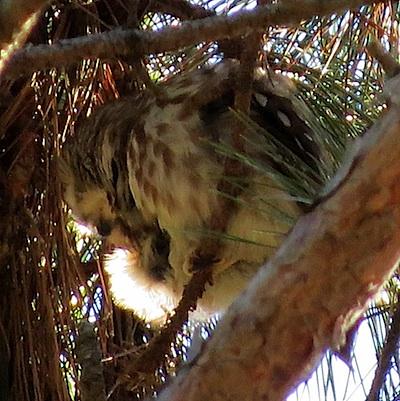
A Costa's hummingbird visited Michigan this month/Kirby Adams
I've spending an awful lot of time thinking about the birds no one sees. That's not something birders, or anyone, ponders often. We like to think about our lists, talk about the birds we've seen and the ones others have seen that we just missed. We don't talk about the birds that no one ever sees, mostly because we don't know anything about them.
When a mega rarity is found, it is almost always the result of a serendipitous and unlikely series of events. Consider a few recent case studies.
In my home state we had a Berylline Hummingbird near Pictured Rocks National Lakeshore in September, followed by a Costa's Hummingbird just south of Sleeping Bear Dunes National Lakeshore to open November. That's two hummingbirds from the Southwest turning up at feeders in Michigan. In the Berylline's case, the owners of the feeders knew it was an odd bird, but nothing spectacular. It became known to birders only through a few degrees of separation and word-of-mouth. The Costa's was thought to be just an odd-looking Ruby-throated Hummingbird at the house it was visiting for three weeks. It wasn't until it lingered into November that the people in the house mentioned it to someone locally who called a local birder who in turn visited the house. He expected to be able to inform the home owners that they had a rare-in-Michigan, but not unexpected, Rufous Hummingbird. He reports becoming 'weak in the knees' when he saw what it really was ' the first Costa's Hummingbird in Michigan.
A day before that bird became famous, a Gray Kingbird was causing a stir across the state. These flycatchers spend their summers in Florida, but retreat in the winter to the Caribbean and northern reaches of South America. I managed to catch a glimpse of one in Big Cypress National Preserve a few years ago. In what was likely a result of a phenomenon known as 'mirror migration,' this particular Michigan bird appears to have headed 180 degrees from where his fellow kingbirds flew when fall came to Florida. It was only the second time that species has been seen in Michigan, the first being 30 years and one week earlier. It was spotted two days before the wildlife refuge closed for season, near sunset, as a birder was wrapping up his day.

Northern Saw-whet owls can be very, very hard to spot, even when you're looking for them/Jeff Pavlik
Going back a couple summers, there was a highly celebrated Rufous-necked Wood-rail in New Mexico. This skulking denizen of Central America had never been seen in the United States. Birder Matt Daw was spending a day off at his local wildlife refuge and caught site of a Least Bittern in the open. That's not something you see every day, so he flipped his camera to video mode and started filming the heron. Then, in the most famous birding photo-bomb in history, the wood-rail walked out of the reeds and casually strolled behind the bittern. Mayhem in the birding world ensued.
One can't help but muse about the possibilities. How many weird hummingbirds from the deserts hang out around the Great Lakes without being noticed? It would seem highly unlikely that we've noticed all of them ' or even half of them ' given how close we were to not even hearing about these two cases. If that birder hadn't been in just the right spot at the moment that kingbird flew, he wouldn't have seen it, the refuge would have closed for the year, and no one would have known it was there. You also have to wonder how many stops it made between Florida and Michigan, all unnoticed.
The wood-rail boggles the mind. If a skilled birder hadn't decided to kill some time in that spot, and a Least Bittern hadn't decided to give a rare performance in the open, that bird likely would have never been found. What are the odds that that was actually the first one to set foot north of Mexico? It's impossible to say.
Some bird bloggers have hypothesized that between a third to a half of all rare birds are found. David Sibley, author of the Sibley Guide, reasons that the number is likely no more than 10 percent. We obviously have no clue.
It isn't just rare birds that come to mind. I saw a Northern Saw-whet Owl yesterday at dusk. I sort of saw it, actually. I saw part of its striped belly. I only knew it was there, 50 feet up in a red pine, because another birder had noticed it when some birds were mobbing its perch earlier in the day. The owl was, for all intents and purposes, invisible. So, how many Northern Saw-whet Owls have I walked within 100 feet of this week? Go out right now and stroll through a stand of pines in Shenandoah National Park. How many saw-whet owls did you see? Unless you're exceptionally observant and equally lucky, you likely saw none. But how many owls were in your presence on that walk? No one can say. That's one more thing that makes birding awesome.

 Support Essential Coverage of Essential Places
Support Essential Coverage of Essential Places







Comments
Interesting article, Kirby. I guess this is one of the factors encourages birders at all levels of expetise to keep their eyes (and ears) open, whether we're at home or in a new location :-)